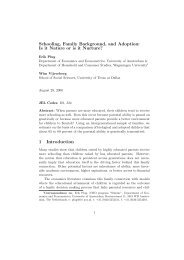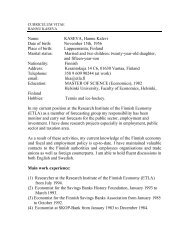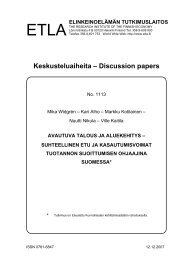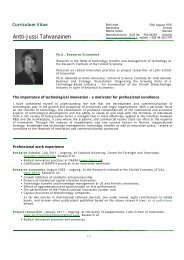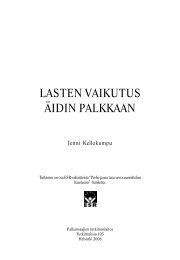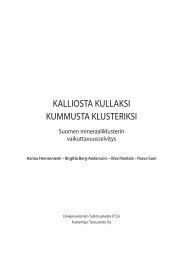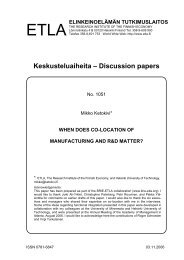Sergey Boltramovich, Grigory Dudarev, and Vladimir Gorelov ... - Etla
Sergey Boltramovich, Grigory Dudarev, and Vladimir Gorelov ... - Etla
Sergey Boltramovich, Grigory Dudarev, and Vladimir Gorelov ... - Etla
You also want an ePaper? Increase the reach of your titles
YUMPU automatically turns print PDFs into web optimized ePapers that Google loves.
7<br />
• Consumers – the main consumers of primary goods manufactured<br />
by the companies of the cluster.<br />
An analysis <strong>and</strong> underst<strong>and</strong>ing of the cluster <strong>and</strong> its structure can help<br />
companies to create focused development strategies, <strong>and</strong> authorities to<br />
identify the sources of competitiveness in their particular regions, <strong>and</strong> to<br />
create on the basis of this an efficient <strong>and</strong> active system of general development,<br />
of infrastructure <strong>and</strong> operational environment improvements,<br />
including relevant regulatory acts, actions <strong>and</strong> decrees of the legislative<br />
power.<br />
Although there is an extensive body of theory <strong>and</strong> research behind the<br />
matters presented in this chapter we do not dare to bother readers with<br />
further explanations <strong>and</strong> would like to proceed to the analysis presented<br />
in the following text. Those who are interested to learn more we ask to<br />
refer to the forthcoming book “Advantage Northwest Russia” by<br />
<strong>Grigory</strong> <strong>Dudarev</strong>, Hannu Hernesniemi <strong>and</strong> others where these issues will<br />
be addressed in more detail. A short summary of theoretical routes used<br />
as knowledge basis for the study is presented below in Box 2.1.<br />
Box 2.1 Theoretical Routes<br />
It was long time a widely accepted fact that national <strong>and</strong> regional location is central<br />
to growth, increased welfare <strong>and</strong> well-being. Already in the end of the 19th<br />
century Alfred Marshall introduced “industrial districts”, later Joseph Schumpeter<br />
– “innovation clusters”, Eric Dahmen – “development blocks”, François<br />
Perroux – ”development <strong>and</strong> growth poles”, economic geographers – industrial<br />
<strong>and</strong> “high-technology” agglomerations. These concepts assessed the geographic<br />
concentration of economic activities <strong>and</strong> innovation from different perspectives.<br />
Going here deeper into the intellectual history underlying these approaches <strong>and</strong><br />
the difficulties of making the above concepts analytically operational is beyond<br />
the scope of the present review. Nevertheless we will touch upon their implications<br />
that were integrated into the approach used in our study. The reason why<br />
these concepts were not successful was not because policy makers did not consider<br />
them important: the source of growth <strong>and</strong> the origins of disparities have<br />
remained central to the preoccupations of policy makers <strong>and</strong> analysts. The unresolved<br />
issues that underlie the wide use of the “cluster” concept are related to<br />
the following questions: Why do activities cluster? Why is clustering important?<br />
How can the clustering process be managed? Is that possible? What are the possible<br />
tools <strong>and</strong> factors that could influence clustering in certain regions? Can,<br />
<strong>and</strong> should, one do something about it?<br />
Michael Porter in his book “The Competitive Advantage of Nations” presented<br />
some answers <strong>and</strong> explanations for many of the above questions. He<br />
incorporated implicitly many previous developments, mentioned above in the<br />
knowledge base (Rouvinen <strong>and</strong> Ylä-Anttila, 1999). Although, according to<br />
these authors, the framework presented by Porter is rewrap of old ideas, they<br />
agree that the “diamond” model is internally consistent <strong>and</strong> in the line with



